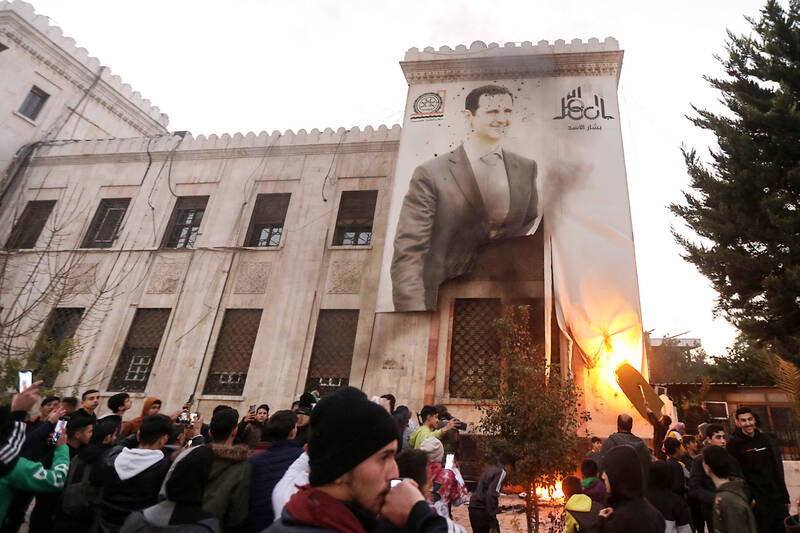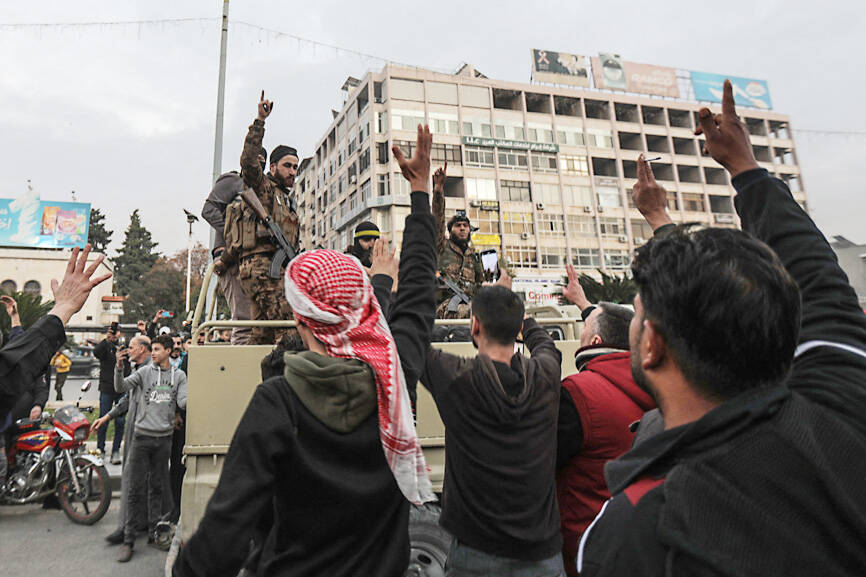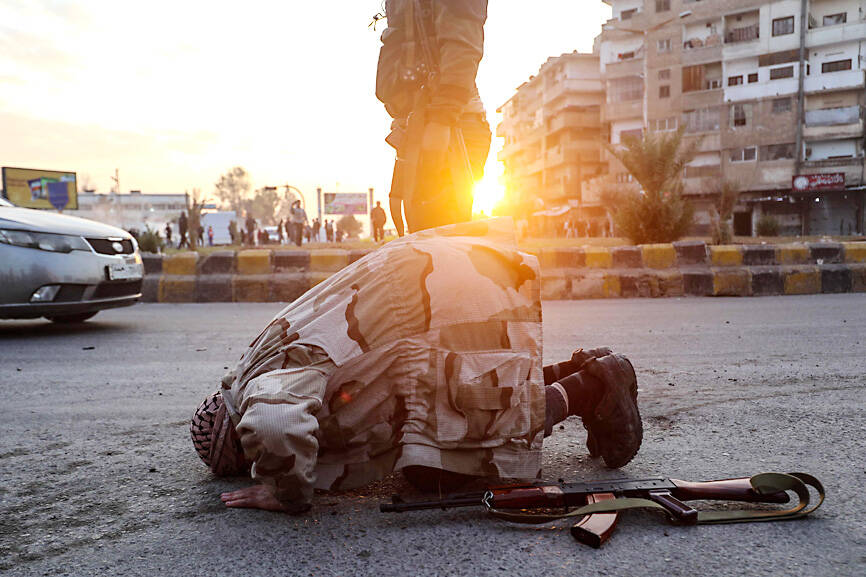It was one of the darkest moments in the modern history of the Arab world. More than four decades ago, then-Syrian president Hafez al-Assad launched what came to be known as the Hama Massacre.
Between 10,000 and 40,000 people were killed or disappeared in the government attack on the central Syrian city. It began on Feb. 2, 1982, and lasted nearly a month, leaving the city in ruins.
The memory of the government assault and the monthlong siege on the city, which at the time was a stronghold of Syria’s Muslim Brotherhood, remains visceral in Syrian and Arab minds.

Photo: AFP
Now Islamist insurgents have captured the city, tearing down a poster of Hafez al-Assad’s son, Syrian President Bashar al-Assad, and swarming security and government offices — scenes unimaginable 40 years ago.
The moment carried great symbolism in Syria’s long-running civil war, which began 13 years ago, but many say is rooted in Hama.
Hama, Syria’s fourth-largest city, is known for its quaint waterwheels, a landmark attraction along the banks of the Orontes River.

Photo: AFP
In the early 1980s, the city’s name became synonymous with killings.
It was the scene of Muslim Brotherhood-led antigovernmental attacks that targeted military officers, state institutions and ruling party offices. In February 1982, Hafez al-Assad ordered an assault on the city to quell the unrest.
In a matter of days, government warplanes destroyed most of the city, opening the way for ground troops.

Photo: AFP
Hafez al-Assad’s brother, Rifaat, led the artillery unit that shelled the city and killed thousands, earning him the nickname the “Butcher of Hama.”
Only this year, Rifaat al-Assad was indicted in Switzerland for war crimes and crimes against humanity in connection with Hama. An international arrest warrant was issued for him three years earlier.
The massacre created resentment that fanned the flames of another uprising against Hafez al-Assad’s son years later.
In 2011, Hama and surrounding towns became the epicenter of some of the biggest protests against Bashar al-Assad, which started in 2011 during a wave of Arab uprisings.
The protests forced government security forces to withdraw from the city briefly in June 2012, leaving the opposition in control and fueling a brief sense of liberation, in a place that Syrian warplanes had once pounded.
Residents at that time painted walls around the city in red, threw red paint on the waterwheels to symbolize the Hama massacre and tried to organize local administration. About 800,000 people lived there at the start of the uprising.
Erhal ya Bashar, a protest chant that means “Come on, leave, Bashar,” was popularized in the Hama protests.
However, government forces returned in August of that year, with a brutal assault that caused mass casualties in the first 24 hours. The leader of the chants was later killed, his throat slit by government forces.
Aron Lund of the New York-based Century International think tank said Hama has obvious symbolic value because of the history of the massacre.
He said it is a “huge event in Syrian history and really formative for the opposition and the Islamist opposition in particular.”
The brutal crackdown is commemorated each year.
It was also formative for government forces, because many of the current military leaders were young at the time, Lund said.
“When 2011 rolled around, they all realized that… we all remember, you all remember Hama. So there’s no compromising here,” he said.
Abu Mohammed al-Golani, the de facto leader of the Syrian insurgency, in a video message on Thursday, announced that fighters had reached Hama “to clean the wound that has bled for 40 years.”
One of the opposition fighters’ first moves was to free prisoners from the city’s central prison.
Hama is a major intersection in Syria that links the country’s center with the north as well as the east and the coast.
It is about 200km north of the capital, Damascus, Bashar al-Assad’s seat of power. Hama Province also borders the coastal province of Latakia, a main base of popular support for al-Assad.
The region is predominantly Sunni Muslim, but also has a minority from the Alawite sect, an offshoot of Shiite Islam, to which al-Assad’s family belongs.
Hama’s fall would have been a massive development in its own right, but coming after the fall of Syria’s largest city, Aleppo, last week, which gave government forces the time to prepare their defense lines, “will absolutely encourage Assad’s enemies and discourage his supporters,” Lund said.
The next stop for the insurgents is the central province of Homs, which analysts have said would be a game-changer if it falls into rebel hands. Insurgent groups have already said they are advancing toward Homs.
Homs, about 40km south of Hama, is where one of Syria’s two state-run oil refineries is located and is also the gateway to Damascus.
It connects the capital to the coast, where Bashar al-Assad has his base and his village of origin.
It is also home to a Russian naval base.
“Should the rebels be able to seize Homs, which they now have a shot at doing after seizing Hama, then they could theoretically have grabbed” three of Syria’s largest cities and severed the capital from the coast, Lund said.

‘UNUSUAL EVENT’: The Australian defense minister said that the Chinese navy task group was entitled to be where it was, but Australia would be watching it closely The Australian and New Zealand militaries were monitoring three Chinese warships moving unusually far south along Australia’s east coast on an unknown mission, officials said yesterday. The Australian government a week ago said that the warships had traveled through Southeast Asia and the Coral Sea, and were approaching northeast Australia. Australian Minister for Defence Richard Marles yesterday said that the Chinese ships — the Hengyang naval frigate, the Zunyi cruiser and the Weishanhu replenishment vessel — were “off the east coast of Australia.” Defense officials did not respond to a request for comment on a Financial Times report that the task group from

DEFENSE UPHEAVAL: Trump was also to remove the first woman to lead a military service, as well as the judge advocates general for the army, navy and air force US President Donald Trump on Friday fired the chairman of the Joint Chiefs of Staff, Air Force General C.Q. Brown, and pushed out five other admirals and generals in an unprecedented shake-up of US military leadership. Trump wrote in a post on Truth Social that he would nominate former lieutenant general Dan “Razin” Caine to succeed Brown, breaking with tradition by pulling someone out of retirement for the first time to become the top military officer. The president would also replace the head of the US Navy, a position held by Admiral Lisa Franchetti, the first woman to lead a military service,

Four decades after they were forced apart, US-raised Adamary Garcia and her birth mother on Saturday fell into each other’s arms at the airport in Santiago, Chile. Without speaking, they embraced tearfully: A rare reunification for one the thousands of Chileans taken from their mothers as babies and given up for adoption abroad. “The worst is over,” Edita Bizama, 64, said as she beheld her daughter for the first time since her birth 41 years ago. Garcia had flown to Santiago with four other women born in Chile and adopted in the US. Reports have estimated there were 20,000 such cases from 1950 to

CONFIDENT ON DEAL: ‘Ukraine wants a seat at the table, but wouldn’t the people of Ukraine have a say? It’s been a long time since an election, the US president said US President Donald Trump on Tuesday criticized Ukrainian President Volodymyr Zelenskiy and added that he was more confident of a deal to end the war after US-Russia talks. Trump increased pressure on Zelenskiy to hold elections and chided him for complaining about being frozen out of talks in Saudi Arabia. The US president also suggested that he could meet Russian President Vladimir Putin before the end of the month as Washington overhauls its stance toward Russia. “I’m very disappointed, I hear that they’re upset about not having a seat,” Trump told reporters at his Mar-a-Lago resort in Florida when asked about the Ukrainian